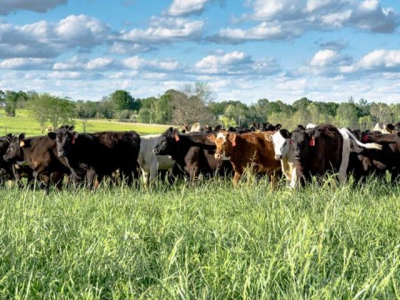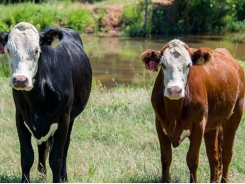Multiple options available to manage cattle nutrients

Cattle graze large areas to consume sufficient forage, and there are various ways to help with cattle redistributing nutrients in confined areas.
Cattle convert grass into meat, but they have to roam large areas to gather sufficient amounts of plant tissue for growth and maintenance. Dirk Philipp, associate professor of animal science for the University of Arkansas System Division of Agriculture, said in doing so, cattle redistribute nutrients and concentrate them in a confined area.
Concentrations of nitrogen in a manure or urine patch can reach up to several-hundred pounds per acre, if extrapolated, Philipp said. Urine and manure undergo immediate decomposition, mainly driven by soil moisture. The resulting concentrations of nutrients in those confined areas can exceed plants' needs by several orders of magnitude, and the excess nutrients are left in the soil.
“Management strategies are needed to redistribute the nutrients as evenly as possible,” Philipp said. “The biological processes involved make redistribution challenging. Since pastures and forage plants benefit most from even soil fertility, producers should strive for managing towards an even redistribution of nutrients as well.”
There are a variety of ways to achieve that, including proper grazing methods that move cattle around. Rotational stocking is popular, but a few things should be considered, he said.
Strip grazing is a good method for grazing stockpiled forage, Philip said. If there are strips available for cattle daily, they will graze evenly and not trample fresh forage. Placing heavily used areas strategically and monitoring water access are also options for encouraging soil fertility and an even distribution of nutrients. High-traffic areas like shade, feeders and salt licks should be moved frequently, if possible.
“Don’t put the feeder next to a gate where they will loaf anyway,” Philipp said. “Cattle congregate around these features.”
Farmers should also discourage animals from spending extended periods of time around ponds or creeks, Philipp said. Cattle are prone to urinating in bodies of water, leading to many nutrients being lost.
Fencing ponds and only allowing cattle access to one section is a feasible and cost-effective approach, Philipp said.
Soil sampling is another key tool for farmers and ranchers in managing the nutrient load on their acreage.
“When soil sampling, sample heavy-use areas separately to account for differences in nutrient levels across the landscape,” Philipp said.
Có thể bạn quan tâm
Phần mềm

Phối trộn thức ăn chăn nuôi

Pha dung dịch thủy canh

Định mức cho tôm ăn

Phối trộn phân bón NPK

Xác định tỷ lệ tôm sống

Chuyển đổi đơn vị phân bón

Xác định công suất sục khí

Chuyển đổi đơn vị tôm

Tính diện tích nhà kính

Tính thể tích ao hồ




 Protein in dairy diets: not as simple as…
Protein in dairy diets: not as simple as…  Methane cutting efforts shift focus to pasture-fed cattle
Methane cutting efforts shift focus to pasture-fed cattle